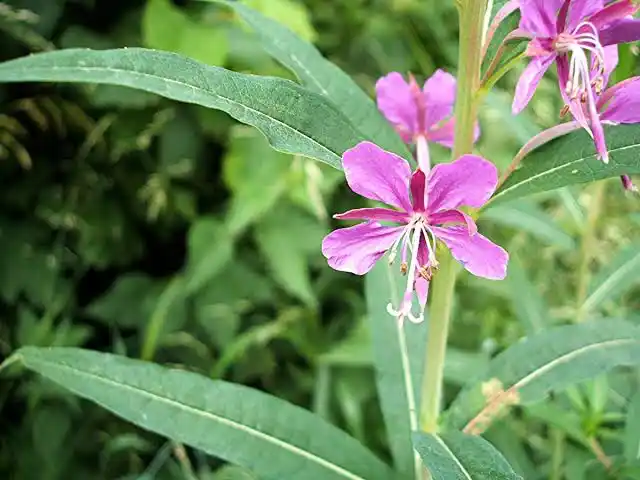Rosebay Willow herb, scientifically known as Chamerion angustifolium and commonly referred to as Fireweed, is a herbaceous perennial plant that belongs to the Onagraceae family.
This resilient and adaptable wildflower is native to regions of the Northern Hemisphere, including North America, Europe, and Asia. Its ability to colonize disturbed areas, especially after wildfires, has earned it the name Fireweed.
One of the most distinctive features of Rosebay Willowherb is its tall, slender stems that can reach heights of up to several feet. The plant produces lance-shaped leaves that are arranged alternately along the stem.
The vibrant, magenta to pinkish-purple flowers bloom in terminal spikes, creating a stunning display that contrasts sharply with the green foliage. The blooms are not only visually striking but also attract pollinators such as bees and butterflies.
Fireweed’s name is derived from its characteristic ability to quickly colonize open areas, particularly after forest fires. The plant is an early successional species, meaning it is one of the first plants to appear in areas that have been disturbed by fire or other natural events.
Its presence in these environments plays a crucial role in soil stabilization and the initiation of ecological recovery.
In addition to its ecological importance, Fireweed has cultural significance and has been used traditionally for various purposes. Indigenous peoples in North America have utilized different parts of the plant for medicinal and nutritional purposes.
The young shoots and leaves are edible and can be consumed as greens, while the fluffy seeds have been used as a flour supplement. The plant has also been employed in traditional herbal medicine for its purported anti-inflammatory and astringent properties.
The life cycle of Fireweed is intriguing. The plant’s seeds are dispersed by wind, and it is often one of the first plants to establish itself in a disturbed area.
As the environment matures, Fireweed gradually gives way to other plant species in a process known as ecological succession.
Beyond its ecological and cultural roles, Fireweed has found a place in gardening and landscaping for its ornamental value. Its vibrant flowers make it a popular choice for wildflower gardens, adding a burst of color and attracting beneficial insects.
Rosebay Willowherb, or Fireweed, is a resilient and visually striking wildflower that plays a vital role in ecosystem recovery after disturbances.
Its ecological adaptability, cultural uses, and ornamental appeal make it a fascinating and valuable part of the natural world. Whether thriving in post-fire landscapes or gracing gardens with its vibrant blooms, Fireweed stands as a testament to nature’s ability to rejuvenate and thrive in the face of change.
The Botanical Description of Rosebay Willow Herb
1. Physical Appearance: Rosebay willow herb, scientifically known as Chamerion angustifolium, presents as a perennial herbaceous plant. Its slender stem can reach impressive heights, often towering between 3 to 7 feet tall. The leaves are elongated and narrow, with a smooth texture and finely toothed margins, arranged alternately along the stem.
2. Flowering Structure: The plant boasts striking pink to purple-hued flowers that form dense, elongated spikes at the top of the stems. These blooms, typically in full splendor during the summer months, create a vibrant visual spectacle across fields and open spaces.
3. Root System: Rosebay willow herb has an extensive and fibrous root system, which aids in its resilience and ability to thrive in various soil types.
The Geographic Distribution of Rosebay Willow Herb
1. Native Range: Rosebay willow herb is native to regions across the Northern Hemisphere, spanning North America, Europe, and parts of Asia. Its adaptability allows it to flourish in diverse habitats, from open meadows to disturbed areas such as roadsides and forest clearings.
2. Global Spread: Due to its hardiness and prolific nature, Rosebay willow herb has become naturalized in many regions worldwide. It’s found in temperate climates and can even thrive in subarctic environments.
3. Ecological Significance: This plant plays a crucial role in various ecosystems, offering habitat and food for pollinators like bees and butterflies. Its presence often indicates ecological succession in disturbed areas.
The Chemical Composition of Rosebay Willow Herb
1. Phytochemicals: Rosebay willow herb contains a diverse array of compounds, including flavonoids, phenolic acids, and tannins. These phytochemicals contribute to its medicinal properties and potential health benefits.
2. Medicinal Components: Studies suggest that Rosebay willow herb contains substances with anti-inflammatory and antioxidant properties. Extracts from this plant have been explored for their potential in traditional medicine, although further research is ongoing to understand their full therapeutic capabilities.
3. Cultural Significance: Historically, indigenous cultures have utilized various parts of the Rosebay willow herb for medicinal purposes, including teas or poultices for addressing certain ailments.
Read Also: 17 Medicinal Health Benefits Of Guggul (Commiphora wightii)
The Medicinal Health Benefits Of Rosebay Willow Herb (Fireweed)

1. Anti-Inflammatory Properties: Rosebay willow herb exhibits anti-inflammatory effects, potentially beneficial in managing conditions associated with inflammation.
2. Antioxidant Power: Rich in antioxidants, this plant may help combat oxidative stress, supporting overall health and well-being.
3. Respiratory Health: Traditionally, Rosebay willow herb has been used to address respiratory issues, offering relief from coughs and congestion.
4. Digestive Aid: It may act as a digestive aid, promoting gastrointestinal health and easing discomfort.
5. Wound Healing: The plant’s properties suggest potential benefits for wound healing, both internally and externally.
6. Mood Regulation: Some studies propose a connection between Rosebay willow herb and mood regulation, potentially contributing to mental well-being.
7. Immune System Support: Certain compounds in the plant may boost the immune system, aiding in overall health.
8. Urinary Tract Health: Traditional uses include promoting urinary tract health, possibly preventing infections.
9. Cardiovascular Benefits: Preliminary research hints at cardiovascular benefits, such as supporting heart health.
10. Anti-Cancer Properties: While more research is needed, there’s interest in Rosebay willow herb’s potential anti-cancer properties.
11. Hormonal Balance: Traditional medicine suggests it may help maintain hormonal balance in certain situations.
12. Pain Management: The plant could have analgesic properties, offering relief from certain types of pain.
13. Skin Conditions: Topical applications might aid in managing various skin conditions, from irritation to minor infections.
14. Anti-Anxiety Effects: Some anecdotal evidence hints at its potential for calming effects on the nervous system.
15. Detoxification Support: It may assist in detoxifying the body by supporting liver function.
The Methods of Usage to Achieve the Provided Health Benefits Of Rosebay Willow Herb
1. Herbal Teas: Brewing Rosebay willow herb leaves into teas is a common method, providing a convenient way to enjoy its benefits.
2. Tinctures: Extracts in alcohol or glycerin form can be used, allowing for easy and precise dosage.
3. Topical Applications: For skin-related benefits, creating salves or creams with Rosebay willow herb extracts can be effective.
4. Inhalation: Inhaling the steam from infusions may provide respiratory benefits.
5. Capsules or Tablets: For those who prefer a more measured approach, supplements are available.
6. Culinary Use: Incorporating Rosebay willow herb in salads or as a seasoning can offer subtle health boosts.
7. Compresses: Applying infused compresses may aid in wound healing and localized relief.
The Side Effects Of Using Rosebay Willow Herb Medicinal Plant
1. Allergic Reactions: Some individuals may experience allergic reactions, especially if sensitive to similar plants.
2. Digestive Discomfort: In rare cases, excessive consumption may lead to digestive issues such as nausea or upset stomach.
3. Skin Irritation: When applied topically, it’s essential to test for skin sensitivity to avoid irritation.
4. Drug Interactions: Consultation with a healthcare professional is advised, as Rosebay willow herb may interact with certain medications.
5. Pregnancy Concerns: Pregnant individuals should exercise caution, as the effects on pregnancy aren’t well-documented.
6. Not for Prolonged Use: Extended usage without professional guidance may lead to unforeseen complications.
7. Potential Blood Pressure Effects: Individuals with blood pressure concerns should monitor their levels, as the plant may influence blood pressure.
8. Avoid for Surgery: Discontinue use before surgery, as Rosebay willow herb might interfere with anesthesia.
9. Not for Children: It’s generally not recommended for children, as the effects on developing systems are unclear.
10. Quality of Products: Ensure the source and quality of Rosebay willow herb products, as variations can impact efficacy and safety.
Read Also: Which Herbs and Spices are good for you (cinnamon, paprika, etc)
The Scientific Research and Studies of Rosebay Willow Herb

1. Antioxidant Properties: Scientific research has delved into the antioxidant potential of Rosebay willow herb, highlighting its ability to combat oxidative stress at the cellular level.
2. Anti-Inflammatory Effects: Studies suggest that certain compounds in Rosebay willow herb may exhibit anti-inflammatory properties, contributing to its traditional use in addressing inflammatory conditions.
3. Pharmacological Investigations: Ongoing pharmacological studies explore the potential medicinal compounds within the plant, aiming to identify specific bioactive substances.
4. Clinical Trials: Some clinical trials have been conducted to assess the safety and efficacy of Rosebay willow herb in various health contexts, providing valuable insights into its potential applications.
5. Immunomodulatory Potential: Research indicates that Rosebay willow herb might have immunomodulatory effects, suggesting a role in supporting the immune system.
6. Wound Healing Properties: Investigations into the wound healing properties of Rosebay willow herb highlight its potential application in traditional medicine for external injuries.
7. Neuroprotective Effects: Preliminary studies suggest a possible link between Rosebay willow herb and neuroprotection, prompting further exploration of its impact on neurological health.
8. Metabolic Benefits: Scientific scrutiny has revealed potential metabolic benefits, sparking interest in its role in managing certain metabolic conditions.
9. Anti-Cancer Research: While in early stages, research has started to explore the potential anti-cancer properties of Rosebay willow herb, opening avenues for further investigation.
10. Cardiovascular Impact: Some studies have examined the cardiovascular effects of Rosebay willow herb, indicating possible benefits for heart health.
11. Antimicrobial Properties: Investigations into its antimicrobial properties shed light on its historical use in addressing infections.
12. Psychological Well-being: Research into the psychological impact of Rosebay willow herb explores its potential in promoting mental well-being and stress reduction.
The Safety Precautions and Recommendations In Using Rosebay Willow Herb Medicinal Plant
1. Consultation with Healthcare Professionals: Before incorporating Rosebay willow herb into your routine, consult with a healthcare professional, especially if you are on medications or have pre-existing health conditions.
2. Allergic Reactions: Be vigilant for signs of allergic reactions, and discontinue use if any adverse effects occur, such as itching, swelling, or difficulty breathing.
3. Dosage Guidelines: Adhere to recommended dosage guidelines, as excessive consumption may lead to unwanted side effects.
4. Pregnancy and Lactation: Pregnant and breastfeeding individuals should exercise caution and seek medical advice before using Rosebay willow herb due to limited data on its safety in these situations.
5. Monitoring Blood Pressure: Individuals with blood pressure concerns should monitor their levels regularly, as the herb may influence blood pressure.
6. Quality Assurance: Ensure the quality and authenticity of Rosebay willow herb products, opting for reputable sources to guarantee purity and effectiveness.
7. Children and Elderly: It’s advisable to exercise caution when considering the use of Rosebay willow herb in children or the elderly, as the effects on these age groups are not well-documented.
8. Discontinue Before Surgery: Discontinue the use of Rosebay willow herb at least two weeks before scheduled surgeries, as it may interfere with anesthesia.
9. Avoid Prolonged Use: Prolonged usage without professional guidance may lead to unforeseen complications, so it’s essential to use the herb judiciously.
10. Combining with Medications: Individuals taking medications should consult with their healthcare provider to rule out potential interactions between Rosebay willow herb and prescribed drugs.
FAQs About Rosebay Willow Herb Medicinal Plant
1. Is Rosebay willow herb safe for daily consumption?
Answer: While generally considered safe, moderation is key. Consult with a healthcare professional for personalized advice.
2. Can Rosebay willow herb be used during pregnancy?
Answer: Pregnant individuals should exercise caution and seek medical advice due to limited data on its safety during pregnancy.
3. What is the recommended dosage for Rosebay willow herb supplements?
Answer: Dosage recommendations vary; it’s advisable to follow the guidelines provided by the product or consult a healthcare professional.
4. Are there any known drug interactions with Rosebay willow herb?
Some medications may interact; consult with your healthcare provider to ensure safety, especially if you are on prescribed drugs.
5. Can Rosebay willow herb be used topically for skin conditions?
Yes, topical applications may be beneficial for managing various skin conditions, but perform a patch test to check for sensitivity.
6. Is Rosebay willow herb suitable for children?
Exercise caution with children, and it’s advisable to consult with a healthcare professional before use.
7. How does Rosebay willow herb taste in herbal teas?
The taste is generally mild and slightly sweet, making it suitable for herbal teas with added health benefits.
8. Are there any known cases of allergic reactions to Rosebay willow herb?
Allergic reactions are rare but possible. Discontinue use if any adverse reactions occur and seek medical attention.
9. Can Rosebay willow herb be used alongside other herbal supplements?
While some combinations may be safe, it’s wise to consult with a healthcare professional to avoid potential interactions.
10. What precautions should be taken when using Rosebay willow herb topically?
Perform a patch test to check for skin sensitivity, and discontinue use if irritation occurs.
11. Is Rosebay willow herb an invasive species?
While adaptable, it may become invasive in certain regions, so it’s essential to be mindful of its growth patterns.
12. Can Rosebay willow herb be grown at home?
Yes, it can be cultivated in gardens, but be aware of its growth potential and consider containment measures.
13. Is there ongoing research into the medicinal properties of Rosebay willow herb?
Yes, research is ongoing, exploring various aspects of its medicinal potential and applications.
14. Can Rosebay willow herb be used as a substitute for other herbs in traditional medicine?
While it has traditional uses, substitution should be approached with caution, considering individual health needs.
15. Is there a recommended age for the use of Rosebay willow herb?
It’s generally advisable to use caution in children and the elderly, with individualized guidance from healthcare professionals.
16. How does Rosebay willow herb interact with the immune system?
Studies suggest potential immunomodulatory effects, but more research is needed for a comprehensive understanding.
Read Also: A Beginner’s Guide to the Warthog

